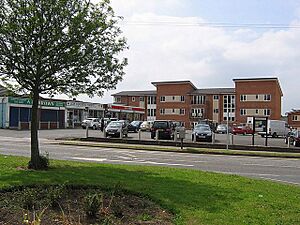Belmont, County Durham facts for kids
Quick facts for kids Belmont |
|
|---|---|
| Population | 8,881 (2011) |
| OS grid reference | NZ305435 |
| Civil parish |
|
| Unitary authority |
|
| Ceremonial county | |
| Region | |
| Country | England |
| Sovereign state | United Kingdom |
| Post town | DURHAM |
| Postcode district | DH1 |
| Dialling code | 0191 |
| Police | Durham |
| Fire | County Durham and Darlington |
| Ambulance | North East |
| EU Parliament | North East England |
| UK Parliament |
|
Belmont is a lively area located in the north-eastern part of Durham, a city in England. It's like a big neighbourhood or suburb. The area known as Belmont Parish includes four older villages: Belmont, Carrville, Broomside, and Gilesgate Moor.
Over time, these villages have grown and joined together. This happened because of new factories and homes built since the 1950s. So, "Belmont" can mean just the old village, or the whole larger parish. The A1(M) motorway cuts through the area. In 2011, about 8,881 people lived in Belmont Parish.
Contents
Belmont's Past and Present Growth
Long ago, Belmont was mostly farmland. But in the second half of the 1800s, things changed. People started digging for coal, and this brought new developments. Several coal mines opened here. The biggest one, Belmont Colliery, was named after Belmont Hall (now called Ramside Hall).
Other mines nearby included Kepier Grange and Carrville. These areas, along with Broomside and Gilesgate Moor, formed the new Belmont Parish in 1852. Even today, the parish boundaries still include these places.
From Mines to Modern Homes
By the late 1800s, most of the coal mines in this part of Durham had closed. Many houses built for miners were even taken down. The Grange Ironworks became the main employer for a while. But without the coal mines, the villages didn't grow much. Some people even moved away. The Ironworks also closed in the 1920s.
Belmont, Broomside, Carrville, and Gilesgate Moor stayed quite small until the 1950s. That's when Durham City started to build many new homes. The High Grange Estate, built in the 1960s, added lots of houses. It connected Gilesgate and Belmont village more closely.
The A1 motorway opened in 1965. This road divided the parish a bit. It separated the eastern parts (Belmont, Carrville, and Broomside) from the western parts (Gilesgate Moor and High Grange).
New Developments and Community Life
More new homes were built in Belmont and Carrville between 1970 and 2000. This made the area's population grow even more. The Dragonville area, part of Gilesgate Moor, saw new factories and then shops from the 1970s onwards. Today, Dragonville has many large shopping centers and supermarkets.
The Belmont Community Centre opened in 1971. It has a small park and is a central place for community events. The local parish council also meets here. To the north, the Belmont Business Park opened in 1995. It includes the New Ferens Park football stadium. This business park has continued to grow with more developments into the 2010s.
What Can You Find in Belmont?
Belmont has a lot of useful places for people who live there.
Schools and Transport
Belmont Community School is the main secondary school for the area. There are also several primary schools in the parish.
Getting around is easy. Major bus routes from Sunderland and Seaham to Durham run through Belmont. This means you can catch a bus often to the city centre. The Belmont Park and Ride opened in 2004. It's near the A1 Motorway junction in the Carrville area. This is a great place to park your car and take a bus into Durham.
Shopping and Leisure
The western part of the parish has many shops and places to buy things. There are also four pubs where people can meet up: the Travellers Rest in Broomside, The Belmont in Belmont, Broomside Park on the Belmont Business Park, and one in Gilesgate Moor. You can also find a small library in Broomside.
Sports in Belmont
Belmont is a place where many different football teams have played.
New Ferens Park Football Stadium
Since 1995, Belmont has been home to New Ferens Park. This stadium has hosted several football clubs.
- Durham City played here from 1995 to 2015.
- Durham Women played their games here from 2014 to 2020.
- Sunderland's reserve team also played at the stadium for a few years in the 2000s.
Belmont Stadium's Past
There was once a place called Belmont Stadium. It was used for greyhound racing from 1940 until 1969. Today, houses stand where the stadium used to be.
Belmont on the Big Screen
Belmont has even appeared in some famous movies!
- Get Carter: A house called "Beechcroft" on Broomside Lane was used in this 1971 film. It was the home of a character named Cliff Brumby. The famous actor Michael Caine, playing Jack Carter, said a well-known line there: "You’re a big man, but you’re out of shape." Even though people wanted to save it, the house was taken down in 2008.
- The Gay Dog: Belmont Stadium was featured in this 1954 film.




